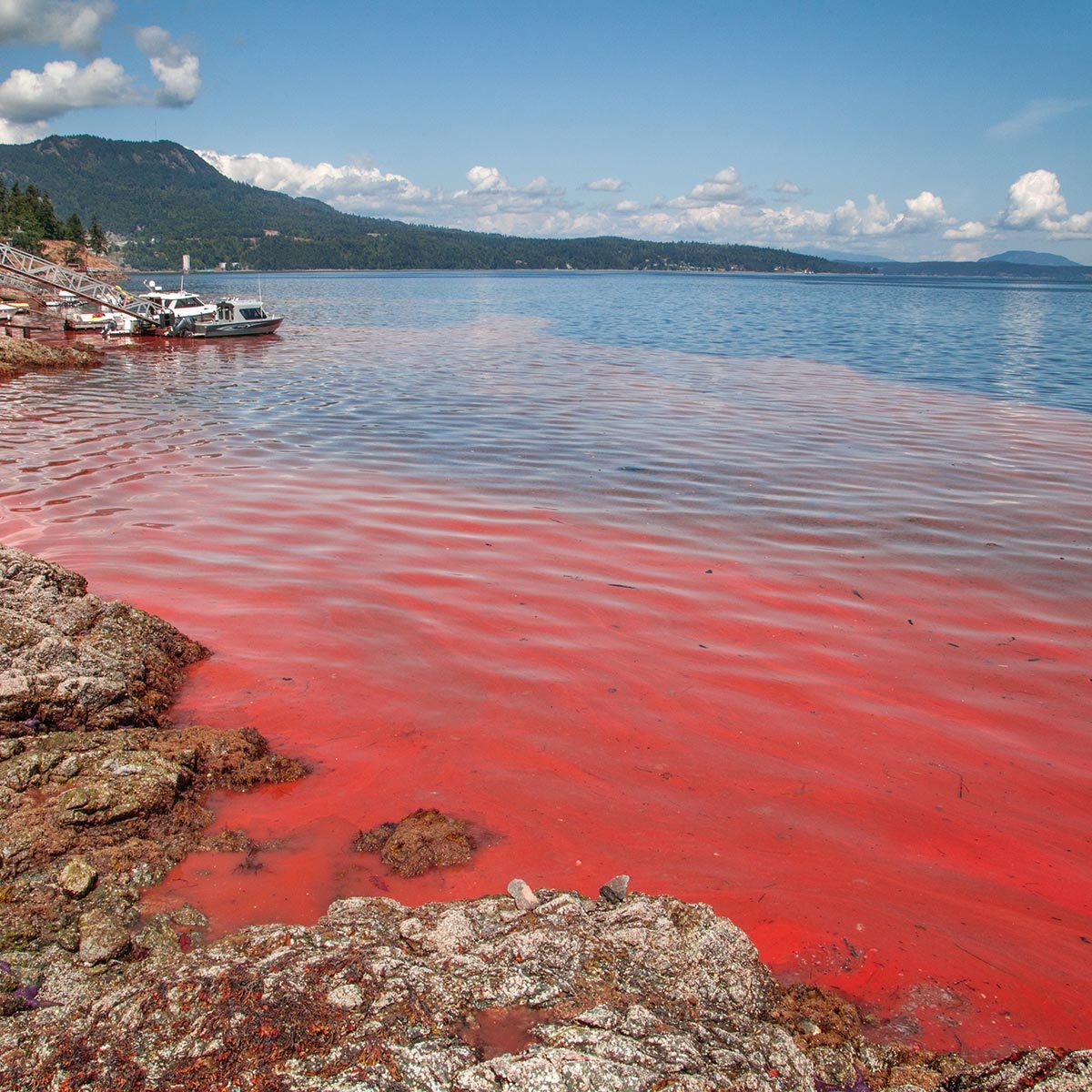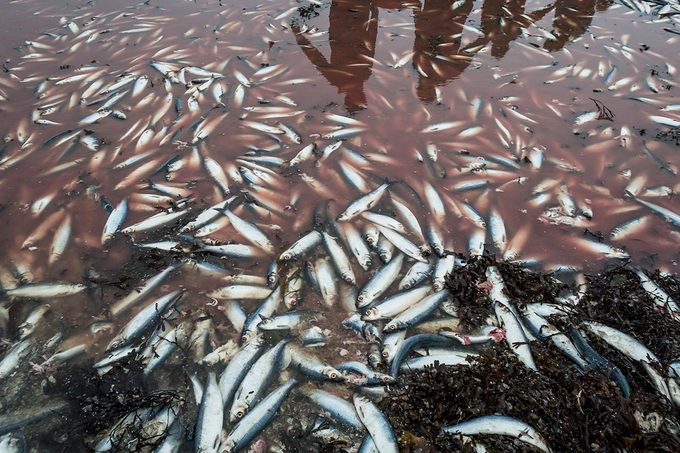That can't be good ...

Here’s Why the Ocean Turns Red—And What to Do If It Happens at Your Spring Break Destination

You go on a beach vacation to relax, sink your toes in the sand and splash in the waves. The last thing you want to see is red ocean water (especially after you paid hundreds, maybe thousands, of dollars to get away). While it may look like a literal bloodbath, red water doesn’t mean there’s a shark snacking nearby … but it’s still not a good thing.
So what causes red tide? And does it mean you need to stay out of the ocean? We went to J.P. Brooker, director of Florida conservation at Ocean Conservancy in St. Petersburg, Florida, to find out the reason for this strange phenomenon. Here’s what swimmers need to know, where red tides happen and whether a red tide could mess with your spring break plans.
Get Reader’s Digest’s Read Up newsletter for more interesting facts, travel, tech, cleaning and humor all week long.
What is a red tide, exactly?
Red tide is a toxic overgrowth of algae in the ocean, according to the National Oceanic and Atmospheric Administration (NOAA). It’s caused by naturally occurring microorganisms, including Karenia brevis, which is always in the Gulf of Mexico. “When these microorganisms multiply out of control, it becomes a red tide,” Brooker explains. The science-y term for it is harmful algal bloom (HAB).
By the way, it’s called a harmful bloom for a reason: It produces toxins that are hazardous to humans and marine life. (More on that below.) The good news is that coastal U.S. states continually monitor the ocean and bay water, and they shut down beaches when it tips into the red tide zone.
Red tides are one of those strange ocean phenomena that go way back. “They were documented by the Spanish in their initial conquest of North America,” Brooker says. And it’s super common in Florida and all along the Gulf Coast. In fact, it has been reported in every coastal state, according to NOAA. Red tides can affect oceans, bays and even estuaries (where fresh and saltwater meet).
What causes this to happen?
Many of our modern-life problems are making red tides more common than they used to be. These are the main factors that cause harmful algal bloom:
High nitrogen levels
“Karenia blooms in profusion when it has lots of food to eat—in particular, it thrives on nitrogen,” says Brooker. Yes, nitrogen is found in nature, but humans contribute massively to excess nitrogen in the environment. “Since nitrogen is a key component of human waste, we’re responsible for a great deal of nitrogen pollution along our coasts, and we’re fueling harmful algal events like red tide with our excess pollution,” Brooker explains.
Warming water temperatures
The ocean is getting warmer and warmer—and “that’s like gasoline on the harmful algal bloom fire,” says Brooker. “We are seeing more frequent and severe red tide events.” Ocean temps keep on peaking: 2024 was the warmest ocean year on record, according to NASA. The Gulf, for instance, is now 3 degrees warmer on average than in previous eras. That may not sound like a lot, but it is.
Is a red tide hazardous?
A red tide is dangerous, for sure. That’s why scientists monitor the fluctuations in these microorganisms and state and local governments alert the public about red tides. Here’s how these algal blooms harm us:
It can damage your heart and nervous system
Eating shellfish tainted with these microorganisms can harm your heart and nervous system, according to the Centers for Disease Control and Prevention (CDC). Ingesting it can give you symptoms ranging from vomiting to an irregular heartbeat. “Red tide microorganisms produce neurotoxins that can be harmful to humans who ingest neurotoxin-affected shellfish,” says Brooker. “People who eat red tide–afflicted oysters can become very sick.”
It can cause breathing problems
Breathing in the toxins from Karenia brevis can trigger shortness of breath, asthma, cough, bronchitis and even pneumonia. It’s particularly dangerous for people with preexisting respiratory issues, but even healthy people can find it hard to breathe during red tide events, Brooker says.
How will you know it’s starting to affect you? “I describe red tide as ‘spicy,'” Brooker explains. “You can feel it in the back of your throat and in your nose, and it makes your eyes water and can make you cough and sneeze.”
It can give you a rash
Contact with this toxin can trigger rashes and irritation of mucous membranes. So during a red tide, you should stay out of the water and even avoid the beach where you could come in contact with contaminated shells, sand and washed-up marine life.
Is a red tide harmful to marine life too?

Red tide is really bad for fish, shellfish and other marine creatures, and it can kill them. “In recent red tide episodes, we’ve seen thousands upon thousands of pounds of fish die,” Brooker says. It’s also devastating for manatees since it blocks out sunlight in the water column and kills seagrass. “A manatee might consume as much as 100 pounds of seagrass in a single day, so manatees can become emaciated and stressed due to a lack of food,” he notes.
The red tide neurotoxin even kills some seabirds. “Cormorants and Anhingas exhibit ‘drunken sailor syndrome,'” Brooker says. “These poor swimming birds become wobbly when they walk on land and stumble and fall over and can ultimately die.”
Can you swim in a red tide?
No, definitely not. It’s not safe to swim in a red tide. If you see dead fish on a beach, that’s a clear sign to not go in the water (even if there’s no official warning in effect). It’s not even a great idea to go on the beach during a red tide, since you can breathe in the toxins from the breeze. If you do get exposed to red tide water, rinse your skin and eyes right away with fresh water.
Will red tide be a problem for spring break 2025?
In southern states like Florida, red tides happen almost every year, often in late summer and fall. That said, this environmental problem can crop up any time of year. The west coast of Florida recently had a red tide situation from mid-February through mid-March, from Tampa to Key West, but the warning was recently lifted. Yay!
Should you cancel your vacation if there’s a red tide happening? These harmful algal blooms sometimes clear in a matter of weeks, so you may not need to. But they can also last—gasp!—a whole year. Even if there is a red tide in effect, you can usually still do super fun things—golf, play tennis, swim in the hotel pool, sip frozen daiquiris … as long as you’re not staying right on the beach.
That said, if you can’t swim in the ocean or eat just-caught fish, it might not be your idea of a beach vacation and you may choose to postpone. And naturally, if there’s a state of emergency and people are being asked to stay indoors, you are definitely better off tabling that trip.
About the expert
|
Why trust us
At Reader’s Digest, we’re committed to producing high-quality content by writers with expertise and experience in their field in consultation with relevant, qualified experts. We rely on reputable primary sources, including government and professional organizations and academic institutions as well as our writers’ personal experiences where appropriate. We verify all facts and data, back them with credible sourcing and revisit them over time to ensure they remain accurate and up to date. Read more about our team, our contributors and our editorial policies.
Sources:
- J.P. Brooker, director of Florida conservation at Ocean Conservancy; email interview, March 17, 2025
- NOAA: “What is a red tide?”
- NASA: “Ocean Warming”
- CDC: “Clinical Signs and Symptoms Caused by Saltwater Harmful Algal Blooms”























